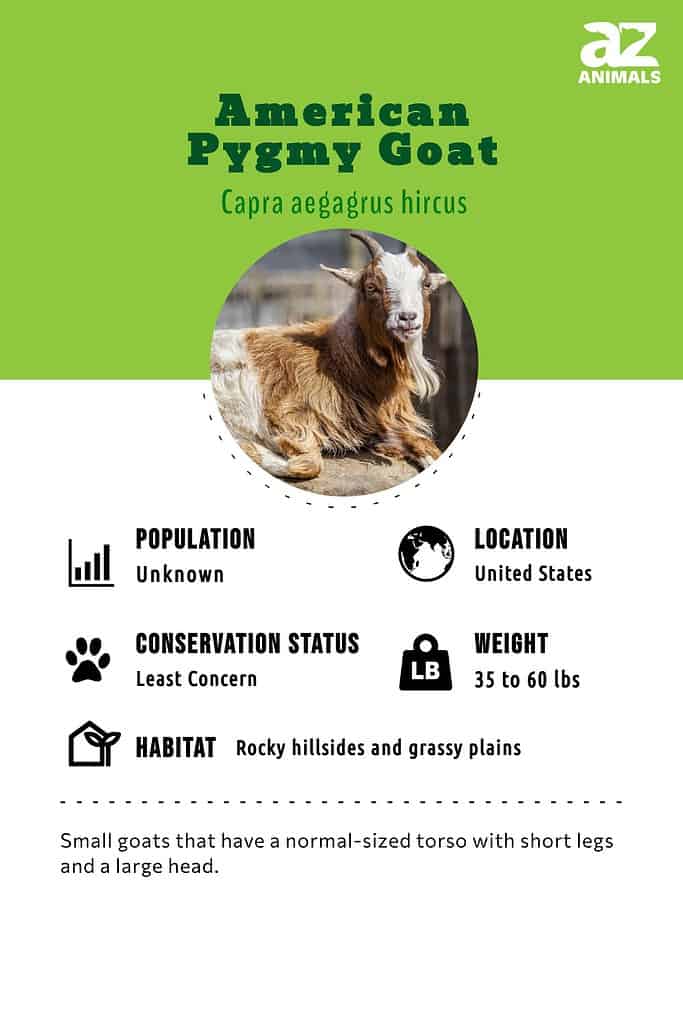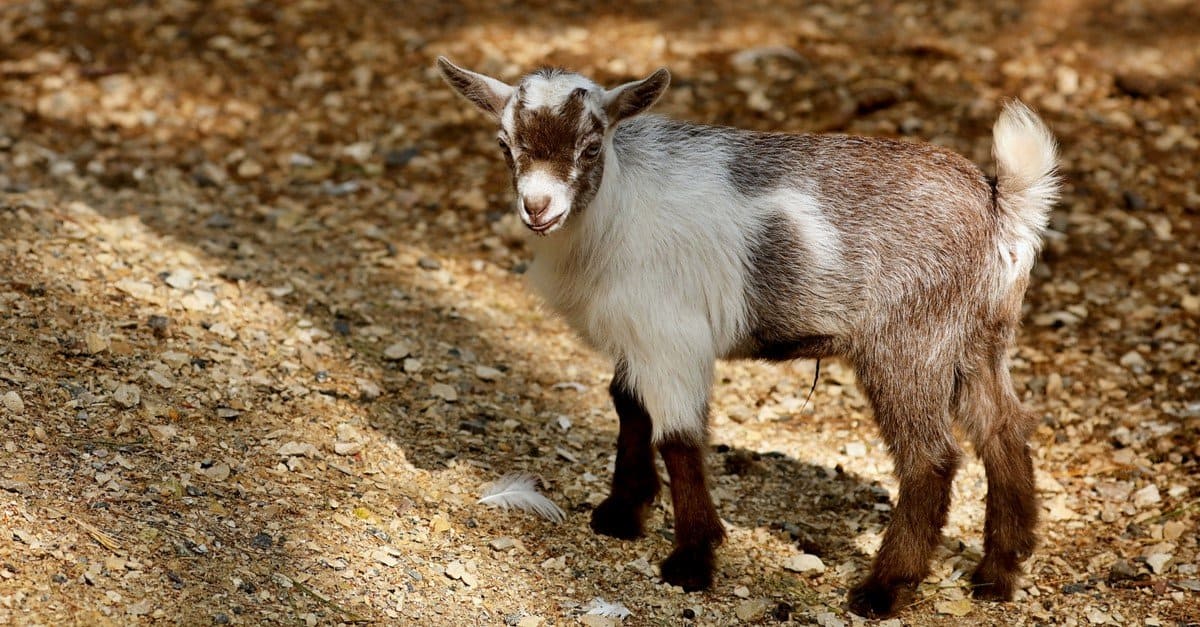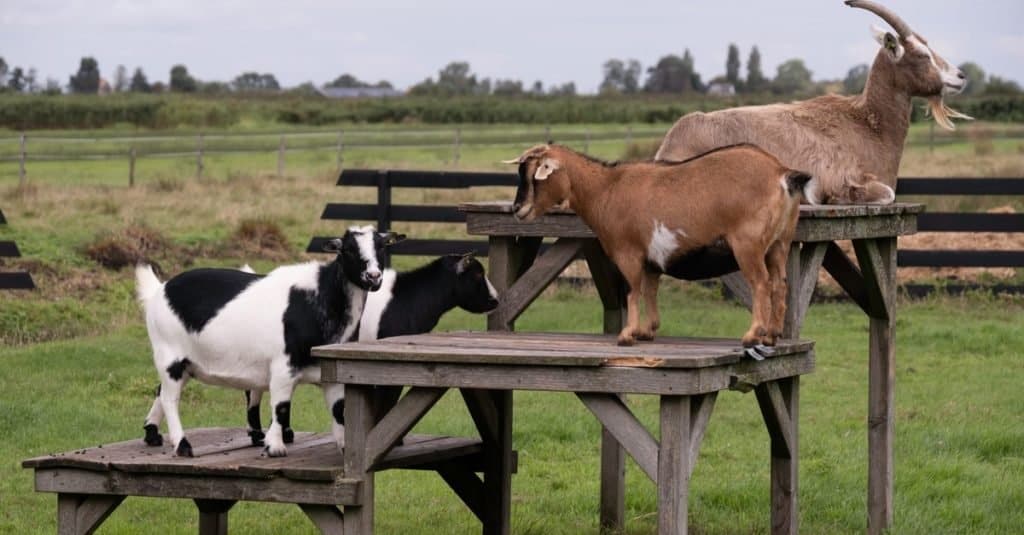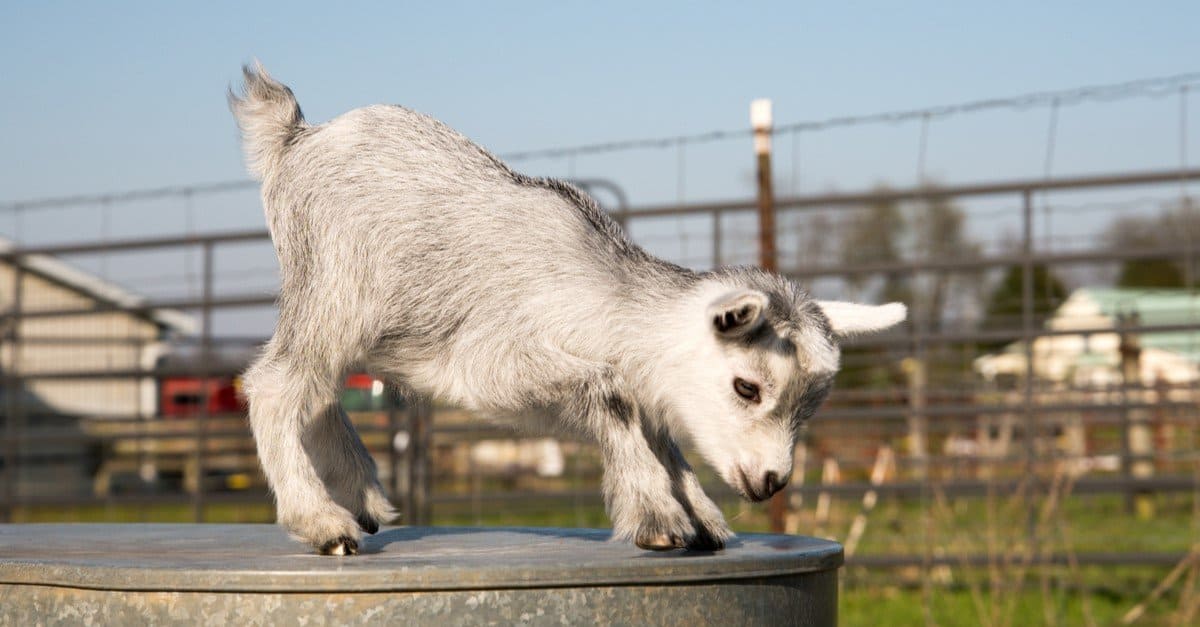American Pygmy Goat
Capra aegagrus hircus
Can jump up to 5 feet
Advertisement
American Pygmy Goat Scientific Classification
- Kingdom
- Animalia
- Phylum
- Chordata
- Class
- Mammalia
- Order
- Artiodactyla
- Family
- Bovidae
- Genus
- Capra
- Scientific Name
- Capra aegagrus hircus
Read our Complete Guide to Classification of Animals.
American Pygmy Goat Conservation Status
American Pygmy Goat Facts
- Name Of Young
- Kid
- Group Behavior
- Herd
- Fun Fact
- Can jump up to 5 feet
- Most Distinctive Feature
- Small size
- Other Name(s)
- Pygmy Goat, African Pygmy, Dwarf Cameroon
- Gestation Period
- 5 months
- Litter Size
- 1-4
- Habitat
- Rocky terrain, Hillsides, Plains, Farmland
- Predators
- dogs, coyotes, bobcats
- Diet
- Herbivore
- Favorite Food
- Greens and grains
- Type
- Mammal
- Common Name
- Pygmy goat
- Location
- United States
American Pygmy Goat Physical Characteristics
- Color
- Grey
- Black
- White
- Caramel
- Skin Type
- Fur
- Lifespan
- 8-12 years
- Weight
- 30-90 lbs
- Height
- 15-20 inches
- Length
- 18-33 inches
- Age of Sexual Maturity
- 2-4 months
- Age of Weaning
- 8 weeks
View all of the American Pygmy Goat images!
The American Pygmy Goat, also known as the African Pygmy, started out by breeding African Dwarf goats in French Cameroon.
They should not be confused with Pygmy Goats of the United Kingdom, which have a much different appearance, though are similar in size. They are not a teacup breed, but they are very small. Most are about one to two feet in height and don’t get much more than a couple of feet long.
5 Incredible American Pygmy Goat Facts!
- These goats are horned on both males and females of the species, so they cannot be sexed using this method.
- A female goat is known as a doe, a castrated male is called a wether, an uncastrated male is a buck, and a baby goat is known as a kid. When raising goats, birthing is referred to as kidding. Once a doe has given birth to at least one baby or kid, she is considered “freshened.”
- These goats are not much bigger than the size of a medium dog.
- They have a moderate gestation period of 5 months, with a lifespan of up to 12 years.
- They are a dwarf breed of goat, rather than a teacup breed.

Scientific Name
The scientific name for these goats is Capra aegagrus hircus.
Evolution And History
The American pygmy goat evolved from the West African dwarf goats that are native to West Africa. It is believed that the dwarfism that is characteristic of these breeds was an evolutionary response to the environmental conditions in the area. The West African dwarf goat was sent to the U.S. from Europe during the early 20th century for use in research and zoos but also went to private owners. By the mid-century, two very specific breeds had developed – the American pygmy and the Nigerian dwarf pygmy.
Appearance

The American Pygmy is an American breed of achondroplastic goat.
©jitkagold/Shutterstock.com
These goats get their small size from achondroplasia, the gene mutation that causes dwarfism, characterized by a normal-sized torso with short limbs and a larger head. They come in three color classifications: Caramel, Agouti, and Black. Agouti, if you don’t know, means that each hair has bands of at least two separate pigments on each strand, though it can be more. This produces a somewhat speckled appearance to the fur.
In those three main color classifications, there are seven recognized color variations. The accepted breed standard colorings are brown agouti, grey agouti, black agouti, solid black, black with white markings, caramel with black markings, and caramel with brown markings.
Behavior
These goats love jumping and climbing. They are very playful, quite social, and are known for being friendly and also curious creatures. This curiosity is where they get their reputation for eating everything. While they eat a wide variety of plants and grains, they nibble things because of their investigation technique. They bite things to find out the nature of them.
Habitat

are often found on farmland but are native to rocky hillsides and grassy plains.
©Henk Vrieselaar/Shutterstock.com
Goats are very adaptable creatures, so they can easily live in many different habitats and climates. Though in the United States, they are often found on farmland, their native roaming grounds tend to be rocky hillsides and grassy plains. Any terrain with both rocks and edible grasses, which also has a nearby water source, is ideal for goats to thrive.
Diet
Their primary diet consists of green grasses and grains, but they also eat things like apples and carrots. They do well with hay, alfalfa, chaff, corn, and other grains, with some mint and fenugreek for variety.
Predators And Threats
The main animals from which pygmy goats, and baby pygmy goats, in particular, are at risk are coyotes and dogs. Due to a baby goat’s small size, and depending on where the goat lives, it may fall victim to bobcats, birds of prey, and foxes.
Reproduction And Life Cycle

American Pygmy Goat kid likes to play and rest.
©jctabb/Shutterstock.com
Though most farmers don’t breed them until they reach about one year of age, an American Pygmy Goat can reach sexual maturity as early as two months of age. These animals have a gestation period of around five months or about 150 days. Unlike many other species, American pygmy goats can breed year-round. These goats have one to four baby goats or “kids” per live birth. Until the kids are weaned, the mother spends several weeks raising them. The mothers care for their young without fatherly assistance. American Pygmy Goats have a lifespan of up to 12 years.
Population
Because these goats are often found in zoos and on farms, their population appears to be thriving and has not been assessed for risk. Their exact population in the wild is unknown, but in the United States, they are found on many farms and in zoos all across the country.
View all 194 animals that start with AAmerican Pygmy Goat FAQs (Frequently Asked Questions)
What is an American Pygmy Goat?
American Pygmy Goats are a type of goat bred from West African dwarf goats from the Cameroon Valley. They are not a form of teacup breed.
Are American Pygmy Goats good pets?
In most cases, yes, they are! They are small, obviously, but easy to care for and they love to play and social interaction. They still need a lot of exercise, so they should not be kept entirely indoors. Females and castrated males will make the best pets. They do best when they have at least one companion. If you find one for sale, try not to buy an adult, as they will probably do better as pets when you are raising them from a baby.
How much does it cost to buy an American Pygmy Goat?
You can usually find a baby American Pygmy Goat for sale for about $100-200, depending on whether or not it is registered. If the animal is registered, it will cost more.
How big is a full grown American Pygmy Goat?
They are not a teacup size breed, so these goats get to be about the same size as medium adult dogs. They can range between a foot to just under two feet high and from two feet to just over two feet long.
What are American Pygmy Goats good for?
American Pygmy Goats are decent milk producers, though they are sometimes used for meat as well. They make good care or companion animals and they are also good in petting zoos. Sometimes, American Pygmy Goats are used for research in laboratories. When they are for sale, it is usually from a breeder, rather than a farm that raises them for meat or milk.
Thank you for reading! Have some feedback for us? Contact the AZ Animals editorial team.
Sources
- Backyard Goats, Available here: https://backyardgoats.iamcountryside.com/health/how-long-do-goats-live/
- Wikipedia, Available here: https://en.m.wikipedia.org/wiki/American_Pygmy
- Goats, Available here: https://goats.extension.org/goat-breeds-pygmy/
- Pygmy Goat Medal Test Study Guide, Available here: http://cekern.ucanr.edu/files/256385.pdf
- Cub Creek Science Camp, Available here: https://cubcreeksciencecamp.com/programs-activities/meet-our-animals/mammals/african-pygmy-goat/
- Rainbow Spring Acres, Available here: https://www.rainbowspringacres.com/pygmy-goats.html
- Rural Living Today, Available here: https://rurallivingtoday.com/livestock/everything-you-need-to-know-about-pygmy-goats/
- Farmhouse Guide, Available here: https://farmhouseguide.com/how-much-does-a-goat-cost/
- Mother Earth News, Available here: https://www.motherearthnews.com/homesteading-and-livestock/pygmy-goats-for-small-farms-zbcz2012
- Smallholder Feed, Available here: https://www.smallholderfeed.co.uk/pygmy-goat-nutrition/

















